Picture this: The year is 1972. You’re a swingin’ flower child, and you want to go kayaking with your sweetheart, feel the groove and sway of the ocean and get in touch with Mama Earth. It’s not much different than today—except you have to go build your own boat. A look back through the history of sea kayaking shows how the sport transformed from a tiny niche activity in 1972 to one of wide and enduring popularity today.
The history of sea kayaking: Popularizing the sport
Someone in your paddling community has a fiberglass kayak mould—probably at the local paddling club. You pay 10 or 20 bucks for the rights to borrow it and go buy some fiberglassing supplies from someone who’s ordered them in bulk. You get a few pointers from the last builder, and so take on the unwritten responsibility to pass your knowledge along to the next.
Or, if you’re lucky, you can find someone with a bit of experience to build you a boat for a few hundred bucks. But more likely they’ll just give you two halves, a deck and a hull, and leave you to do the dirty work—a lot of hours with your head in the cockpit getting high off resin fumes (it is the ‘70s) and mucking around with fiberglass seam tape.

That’s pretty much how it was in the early years of sea kayaking. Boatbuilding was the hazing you went through if you wanted to be a paddler—not a good recipe for a sport’s popularity.
Then, some young kayakers turned their hobby into a business. They started the companies whose names appear on most of the boats we’re paddling today, and between 1974 and 1984, our sport took off. Here’s how it went down.
The history of sea kayaking in the U.S.
The Seattle scene pre-1974
Folding-kayak touring has its own illustrious history throughout the 1900s, but today’s version of sea kayaking didn’t take off until the advent of fiberglass.
It’s only logical that the earliest fiberglass sea kayaks appeared in Seattle, where the Washington Kayak Club already had hundreds of members. Wolf Bauer started up the Washington Fold-Boat Club, the WKC’s forerunner, in the mid-‘50s. WKC members in their German Kleppers or locally built Whalecraft folding kayaks pioneered trips to many now-popular destinations on the West Coast of Vancouver Island and Alaska, often under the guidance of Bob Miller—the WKCs tireless tripping patriarch, who in his lifetime logged nearly 100 trips of a week or longer.
In 1959, WKC member Ted Houk designed the club’s first fiberglass kayak. Called the Gulf Islander, Houk’s kayak was homebuilt in small numbers by WKC members who passed around the mould. Many WKCers were also soon paddling the Tyee I and II, designed by Linc Hales in 1961 and 1964 and sold at area shops well into the ‘70s. Others had homebuilt boats whose hulls resembled European downriver racing kayaks or traditional fold-boats, so that by 1974 when commercial production was just getting going, most Seattle-area kayakers were already paddling fiberglass.
“Will the last person to leave Seattle please turn out the lights.”
The first commercial builders
Whitewater kayaking was big in the early ‘70s, first appearing in the Olympics in 1972 at Munich, and many boat builders came to sea kayaking after being drawn to the glitz of whitewater first—skipping the venerable folding kayak tradition entirely. Around this time, a trio of whitewater boat builders sprang up who would eventually make touring kayaks their core business.
Eddyline Kayaks was started by Tom and Lisa Derrer in 1971 out of a tiny shop in Boulder, Colorado. Eddyline only built whitewater boats, and had no interest in sea kayaks until the Derrers moved to Seattle in 1974.
There, they met Werner Furrer—the name that’s stamped on many of our paddles today. Furrer, a design engineer from Austria who had toured in folding kayaks since the 1940s, built his first fiberglass kayak in 1965—a slender Greenland-style boat he called the Eskimo.
In 1975, before turning his full attention to the paddle business, Furrer designed the WT-500 (Werner Touring, 500 centimetres long). Like most early hardshells, the WT-500 had a rudder, but no hatches or bulkheads; gear was stowed in canvas duffels waterproofed with garbage bags.
The WT-500 became Eddyline’s first sea kayak. Eddyline came out with its first in-house touring design, the Orca, in about 1978. It was the sort of enormous, high-volume, flat-bottomed cruiser that came to typify the West Coast boat.
A wave of layoffs at Boeing had left a lot of unemployed engineers floating around Seattle in 1972. People were joking, “Will the last person to leave Seattle please turn out the lights.” And this was a time when the environmental movement and the outdoor sports craze were taking off. Companies including Jansport and Cascade Designs (of Thermarest fame) were founded by Boeing castaways, as were two more of the first commercial kayak builders: Pacific Water Sports and Easy Rider.
Lee Moyer took his first sea kayak trip with the WKC’s Bob Morris in 1970—“going north out of Tofino”—at a time when the dirt road across Vancouver Island was so new you needed to duct tape your car doors shut to keep the dust out and pack extra spare tires. And Long Beach was home to more back-to-the-land squatters than kayakers.
Most backyard boat builders were using pirated designs, Moyer said, so he and a buddy set out to buy the rights to a legal mould. Pacific Water Sports was the name they made up so they could pass themselves off as a legitimate business when they approached the British builder of a championship whitewater slalom hull. They printed up some official-looking company letterhead and inked a deal.
On his first sea kayak trip north of Tofino, the dirt road across Vancouver was so new you had to duct tape your car doors shut to keep the dust out.
Their new boat building business soon evolved into a paddling retail store and full-time jobs for Lee and Judy Moyer.
In 1974, they designed and built their first sea kayak, the Sea Otter. “Sea kayaking was the biggest part of our business from then on,” said Lee.
The third company in the Seattle early ‘70s trio was Easy Rider, started by Peter Kaupat as a whitewater boat builder in 1970. The first Easy Rider sea kayak, circa 1975, was the Dolphin, designed by Dan Ruuska—another ex-Boeing engineer who went from moulding ultra-sleek engine intakes to hydrodynamic hulls.
“I remember seeing [Dan] in an unemployment line probably in about 1972,” recalled Matt Broze of Mariner Kayaks. “Not too many years later I bought a kayak from him.”
The history of sea kayaking in Canada
In Canada there were a few early fiberglass builders, including a B.C. company that bought Ted Houk’s Gulf Islander design. There was Frontiersman Fiberglass Products of Mission, B.C., building sea kayaks in 1976. And Walter’s Ski Shack in North Vancouver, a shop run by Walter Buchmueller, which built and sold a German-imported design called the Eskie and one of his own designs called the Osprey.
“I remember seeing Dan in an unemployment line. Not too many years later I bought a kayak from him.” —Matt Broze
None of Canada’s big players were on the scene yet when Nimbus kayaks was born. Liberal arts student Steve Schleicher and microbiology instructor Joe Matuska were just a couple more semi-employed whitewater paddlers building paddles and boats for their friends in a converted chicken coop behind Schleicher’s parents’ house near Vancouver. Schleicher recalls that they built their first touring kayak around 1974 and that it actually had hatches and a rudder. The boat sat on display for a whole summer at the Mountain Equipment Coop, back when the fledgling MEC was just a single shop in Vancouver, but found no buyers. Yet Nimbus became a fulltime business by around 1976—“starving to death in the winter.”
Schleicher pegs 1978 as the year the sea kayaking industry came out of the garage. It was for Nimbus, anyway. That was the year they moved out of the chicken coop to a real production facility in Port Coquitlam. By 1982, Nimbus had come up with its flagship Seafarer design, which is still produced. Matuska later left to start up one of today’s dominant paddle companies, Aqua-Bound.
Meanwhile, in the Garibaldi Highlands just south of Whistler Village, a gruff Czech immigrant and whitewater champion named Mike Neckar was also moulding whitewater boats on an informal basis in a falling-down shop in the rainforest.
“Kayakers would tell him what he wanted and he would produce them under the cover of all the trees and secrecy,” is how Allen Slade described the mythic origins of Necky Kayaks. Slade operated Striders sport store at Fourth and Burrard in Vancouver and became Neckar’s first dealer, long before the formal existence of Necky. “This was just Mike Neckar, care of somewhere in Garibaldi Park. You put in an order when you saw him.”
Mike Neckar is one of the industry’s most legendary characters—impossible to reach for a magazine interview, but variously described by others as “kayaking’s 8,000-pound gorilla,” an engineering genius, a magician, and the last person you’d ever expect to see climb into a kayak and make it dance.
Slade had started out by importing Derek Hutchinson Baidarka Explorers from Britain: “When Neckar saw these he thought they were crap,” which seems to have been a typical North American response to the British designs. So together they strived to develop a design that was stable, roomy and comfortable, that the average paddler could take out on the ocean. Neckar came up with a design based on a high-volume whitewater boat, but longer, wider, with a large cockpit.
In what fading memories recall was spring of 1975, Neckar delivered the newly minted boats to Striders himself, showing up with eight of them tied onto the roof of his Plymouth with ropes strapped through the windows. Neckar pulled the kayaks off the car then tossed them on the sidewalk in front of the shop. Slade worried they’d get scratched, and Neckar retorted, “The first time people use them they’re going to get scratched.”
The intractable designer called his first sea kayaks Turkey Boats because he couldn’t think of a better name, or maybe it’s an indication of what he thought of the people who would be paddling them. Nonetheless, he went on to design better-known early Necky models such as the Phoenix, the Gannet and the President by the early ‘80s, and later built some of the world’s finest sea kayaks.
Spreading the gospel
Industry veterans remember the late 1970s and early ‘80s as a time when, if you had a kayak on your car, heads would turn.
“People thought I was nuts,” remembers Moyer. “‘You go out in the ocean in a kayak?’ They thought that was a big daredevil stunt.”
In 1975, Ken Fink, an oceanographer in Maine, started paddling his whitewater slalom boat on the Atlantic Ocean—a not-uncommon way for whitewater kayakers of the day to discover touring. Fink kept at it until he saw an ad for the Nordkapp by Valley Kayaks in 1978. He contacted Frank Goodman to order two boats—one for himself and one for Maine’s attorney general—and received an invitation to become the North American distributor.
Fink became a self-described evangelist for his new low-impact sport. Well into the ‘80s, if Fink saw a kayak on the highway it was probably one he’d sold. Passing a car with a kayak on top, he’d always look at the boat first to find out who was driving. “And if we saw each other on the interstate in enough time, we’d stop… run over to the median strip and talk.” If he parked, he’d invariably return to his car to find someone waiting for him or a note on his windshield from a potential buyer.
As if the Pacific Northwest didn’t already have its share of the action, a few other Seattle companies entered the business in the early ‘80s. Brothers Matt and Cam Broze started Mariner Kayaks in their basement in 1980. And Dan Ruuska of Natural Designs and John Abbenhouse of Northwest Kayaks crossed over from whitewater and began building touring kayaks.
“‘You go out in the ocean in a kayak?’ They thought that was a big daredevil stunt.” —Lee Moyer
“I can recall in 1980 or ‘81 going up to Vancouver Island… and counting 100 windsurfers on cars to one kayak,” said Matt Broze. “I thought, ‘We started building the wrong kind of boats.’” The industry was still in its infancy, but companies saw that touring had a potential mass appeal that whitewater didn’t. The companies were up and running with viable boat designs, and looking for somewhere to grow.
Inventing the kayak store
In the history of sea kayaking there were no exclusive shops for the sport until John Dowd opened Ecomarine in 1980 on Vancouver’s artsy Granville Island. Dowd brought in folding kayaks from Europe and sold many of the new North American designs including Eddyline’s Orca, Pacific Water Sports’ Sea Otter, and Nimbus’ kayaks.
Dowd is also credited with coining the term “sea kayaking” with the publication of his book of that title in 1981. “It wasn’t called sea kayaking until my book came out,” he said. “It was called kayak touring or sea canoeing or canoe touring, blue-water paddling, coastal paddling, all those things.”
Over on Vancouver Island, Brian Henry was a sheet metal mechanic working long overtime during mill shutdowns so he could have maximum time off for skiing and whitewater paddling.
Around 1979, he went on a month-long paddling trip to the Queen Charlottes, a rare thing at the time. “I decided when I came back I wasn’t going to be a construction worker anymore. I was going to be in the kayak business,” he said. Henry opened Ocean River Sports in Victoria in November 1981.
“I just wanted to have a little kayak store that I could run for a few months of the year and I could paddle and I could ski. I used to put a little notice on my door—‘Gone product testing’—and we’d go to the river.”
Henry started designing boats, beginning with a large hatchless sea kayak called the Pisces, which he took to Mike Neckar to get built. After about a year he started his own production of Current Designs kayaks on Vancouver Island.
In 1982, Bob Licht followed the Ecomarine example and opened Sea Trek Ocean Kayak Center in Sausalito, California. The Southwest had its own kayak builder too: Josef Sedivec at EDA Products had been making whitewater racing kayaks and canoes since 1969 and came out with his first sea kayak, the Vagabond, in 1975.
Licht remains a key promoter of kayaking in the American Southwest. Other specialty kayak shops across the continent were not far behind Ecomarine, Ocean River Sports and Sea Trek.
The meeting in Werner’s rumpus room
The sea kayaking industry as we know it did not happen by accident. Sometime in 1981 or 1982, a group of would-be career kayakers met in Werner Furrer’s basement in Seattle and deliberately created it. John Dowd organized the meeting. Attending were Tom Derrer of Eddyline Kayaks, John Abbenhouse of Northwest Kayaks, Lee Moyer of Pacific Water Sports, Brian Henry of Ocean River Sports and others.
They formed the Trade Association of Sea Kayaking (TASK)—now the Trade Association of Paddlesports (TAPS)—and studied the successes and failures of other outdoor industries to put together a plan for theirs.
“That was when we realized that we could be an industry rather than a bunch of guys in their backyards,” said Henry. “Everybody was in it because it was their favourite hobby,” recalled Moyer. “I think TASK did a pretty good job of helping a bunch of amateur businesspeople act a little more professional.” One of TASK’s most important discoveries was of the need for boat pricing that would include a healthy profit margin for builders, retailers and, eventually, distributors.
“The biggest single thing that happened in our industry to make it become what it is was to get the pricing right,” said Dowd. “So suddenly everybody was able to make a living at it.”
The East Coast catches up
Things got off to a slow start in the East. There were a few early builders, including Bart Hathaway who in 1975 licensed a fiberglass touring design to Old Town Canoe. Ken Fink was distributing British boats through his Poseidon Kayak Imports from 1978 on. But there were no prominent kayak builders until Tieken Kayaks.
Harrie Tieken started building flatwater racing kayaks and Derek Hutchinson sea kayaks in Holland in the early 1970s. His business trajectory paralleled that of the West Coast companies, with sales taking off in the early 1980s.
Fast forward to 1987: Tieken brings his business to North America, settling in Musquodoboit Harbour, Nova Scotia. There were “absolutely no more than 10 people” paddling open water in the East at the time, he guesses. “People said the ocean is too dangerous for a kayak. People were laughing at me basically.”
Eventually Tieken provided boats for Scott Cunningham of the Nova Scotia outfitting company Coastal Adventures, which became a key educator and promoter for sea kayaking, and Tieken’s designs, on the East Coast.
Like the other manufacturers, Tieken saw the need for a distinct North American design that was beginner-friendly, so he came up with his flagship, the Sealution, introduced at the L.L. Bean’s Maine symposium in 1988.
Andy Zimmerman of Wilderness Systems (a North Carolina whitewater boat company founded in 1986) purchased rights to produce the Sealution for the U.S. market and went on to make the boat’s plastic version one of the world’s bestselling kayaks.
Sea kayaking settles into the ‘80s
If you had to pick one year in the history of sea kayaking to mark the start of the modern industry you’d begin with 1984. It was the year that two of TASK’s key promotional visions were realized: a magazine and a symposium. John Dowd founded Sea Kayaker in 1984, supported by the advertising revenue of a growing industry. And TASK hosted the first annual West Coast Sea Kayak Symposium in Port Townsend, Washington—modelled after the highly successful Maine Sea Kayak Symposium started in 1982 by Ken Fink with the support of retailer L.L. Bean and Canoe magazine.
The economy had pulled out of the early ‘80s recession and entrepreneurs who had been struggling along since the ‘70s found themselves with viable businesses. Companies like Current Designs began to reap the support of the big-box U.S. outdoor stores like L.L. Bean in the East and REI in the West. And kayaks entered mainstream media and mainstream consciousness.
1984 was also the year that plastic kayaks came out, with the introduction of the Aquaterra Chinook, made by whitewater boat giant Perception. Plastic kayaks cut boat prices in half. Where fiberglass moulding took at least a day, plastic mould could produce a kayak in about two hours. “Tupperware boats” propelled the industry into the 1990s decade of double-digit annual growth.
Many of the original manufacturers—Necky, Current Designs, Tieken—sold to larger American companies. But others, like Steve Schleicher and Tom Derrer, are still at the helm of the businesses they started three decades ago. Now it’s a heck of a lot simpler to get a sea kayak and the road to Tofino is much smoother than it was in the days of the hippie squatters, but the down-to-earth soul of kayaking is as real as it was back in the day.
“The goal was always to have a really neat way to travel in the wilderness, self-propelled,” said Schleicher, reflecting on where his early vision has led him. “And that seems to be what most of our boats are actually geared to doing.”
Peace out.
Tim Shuff loves to think that it all began on his birthday in 1972, but he’s still trying to get his facts straight.
Feature Photo: Eddyline Kayaks collection



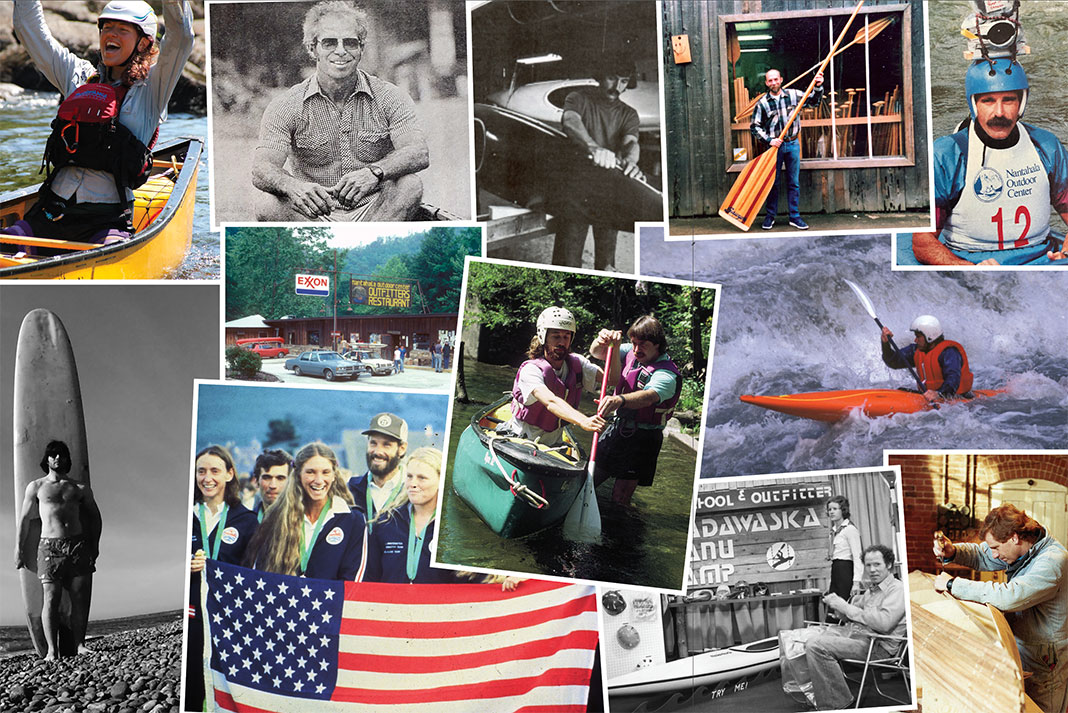

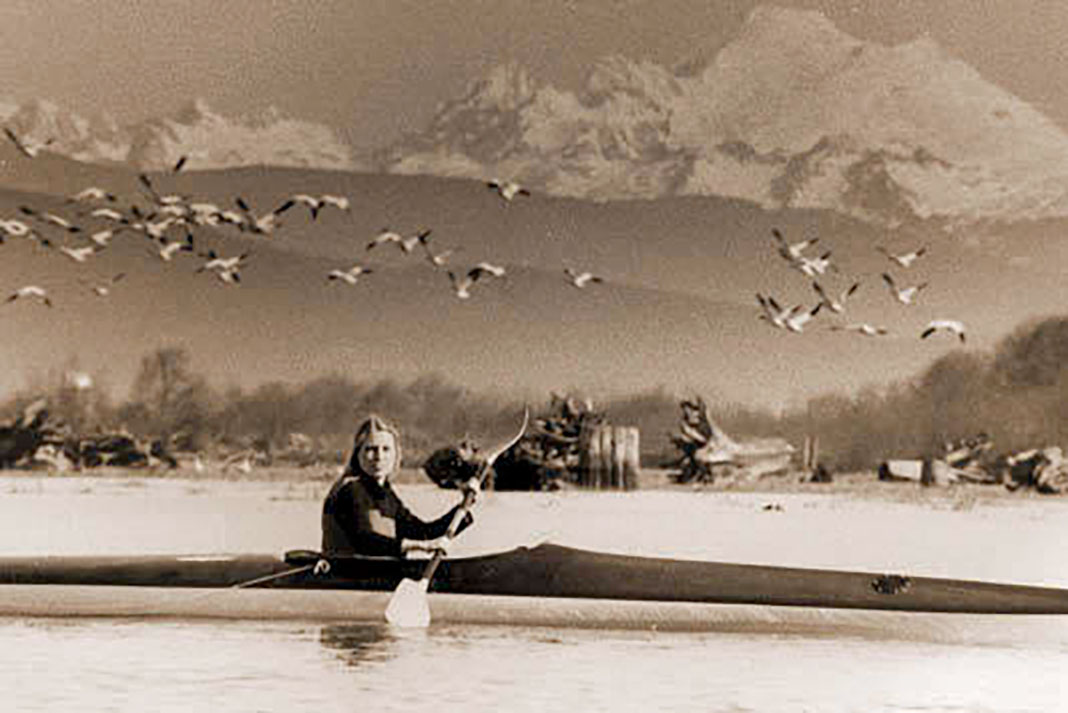
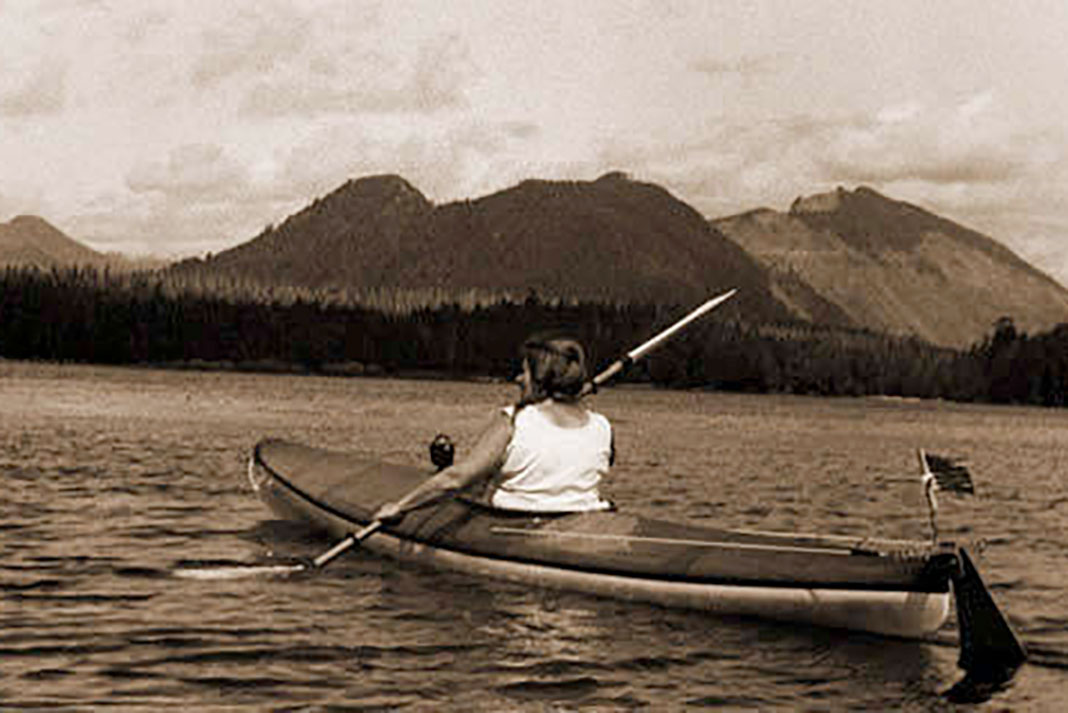
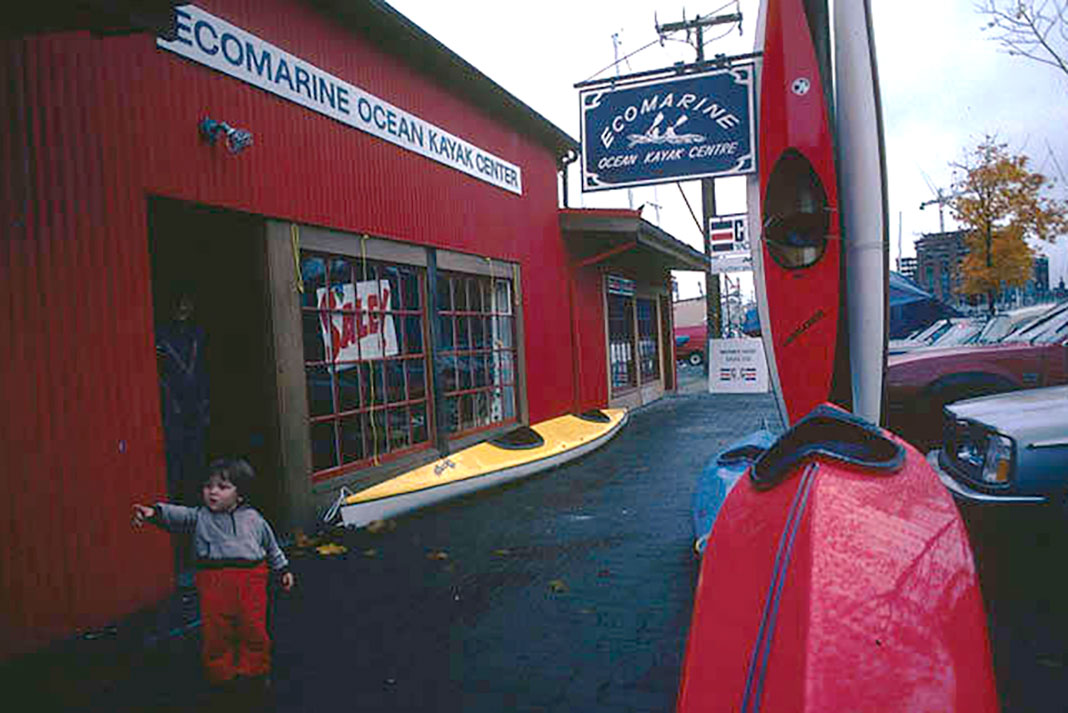
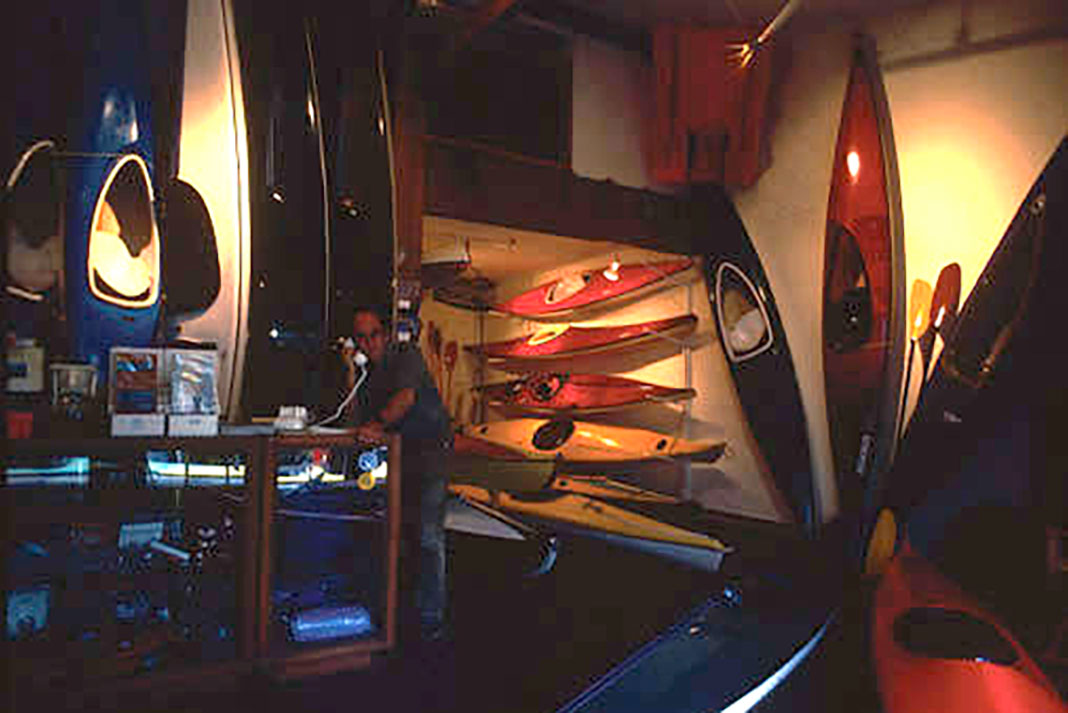
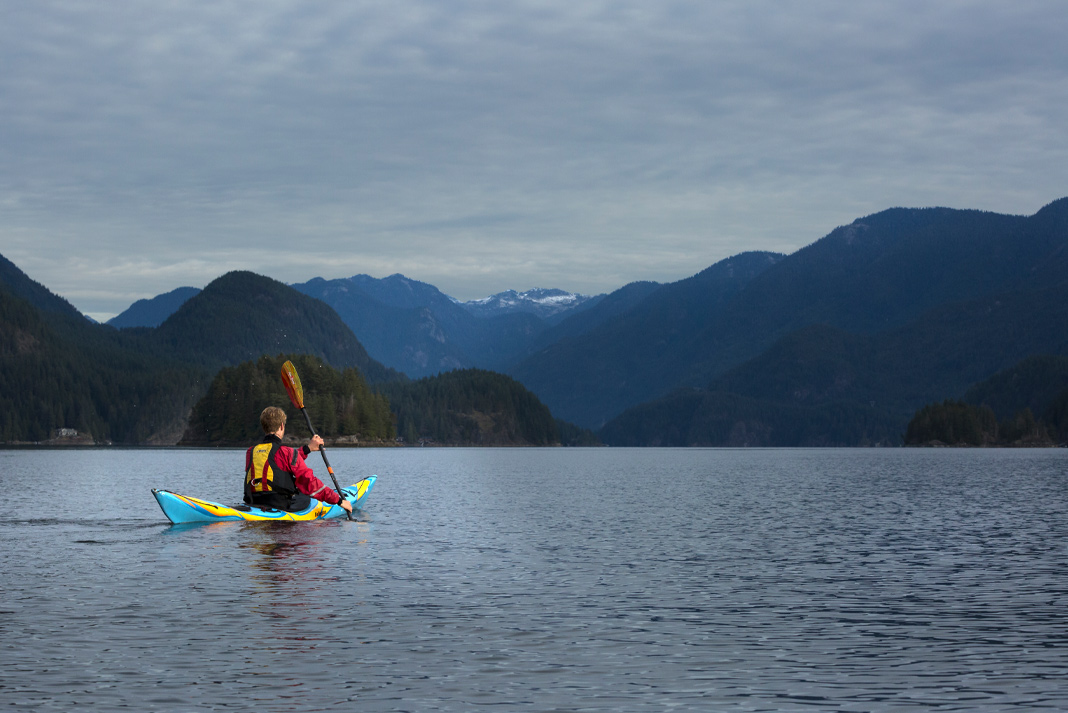

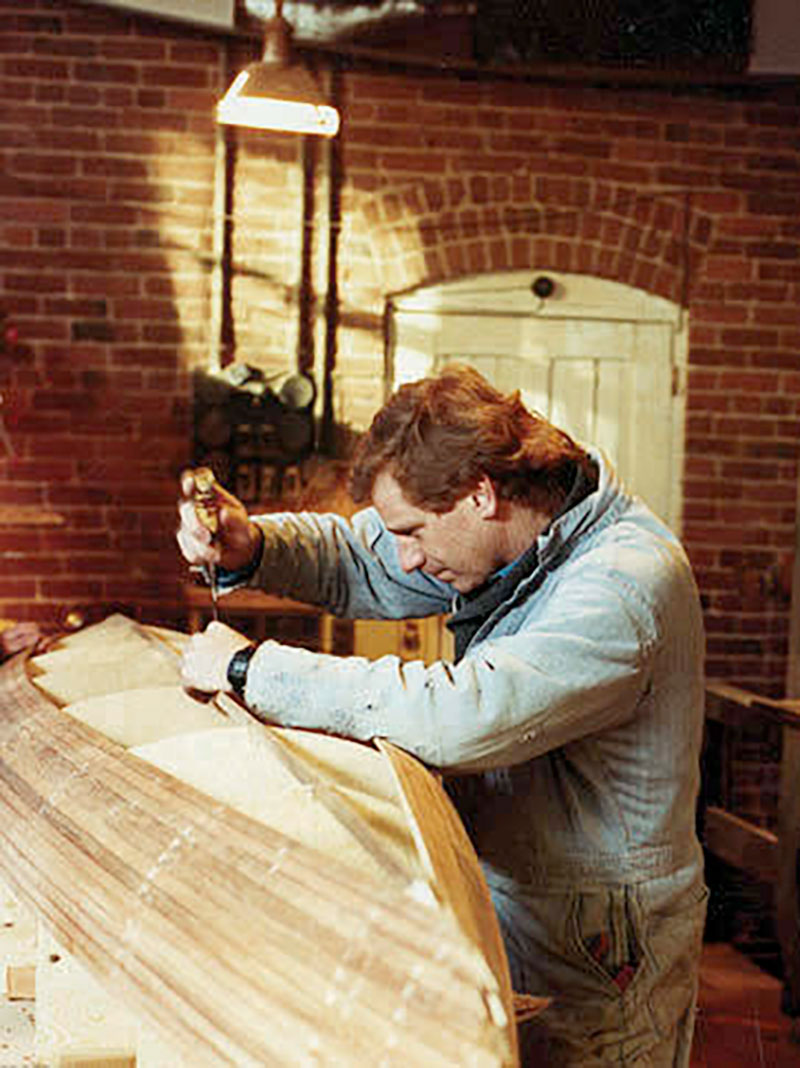
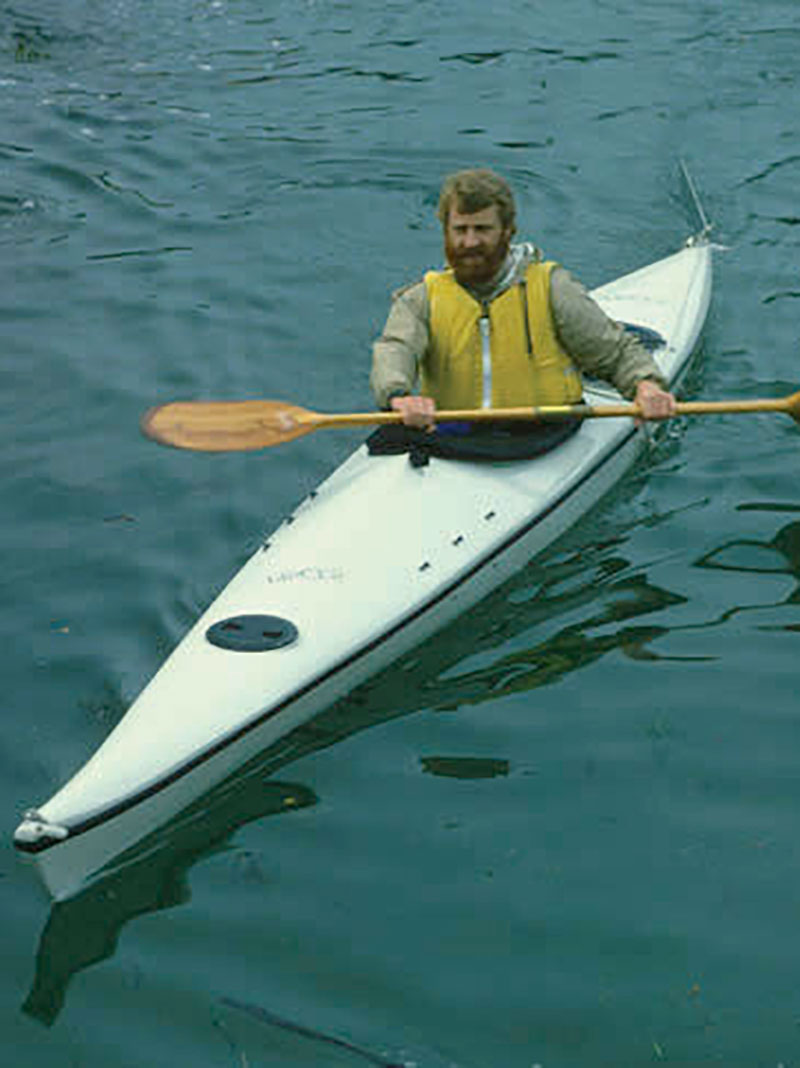
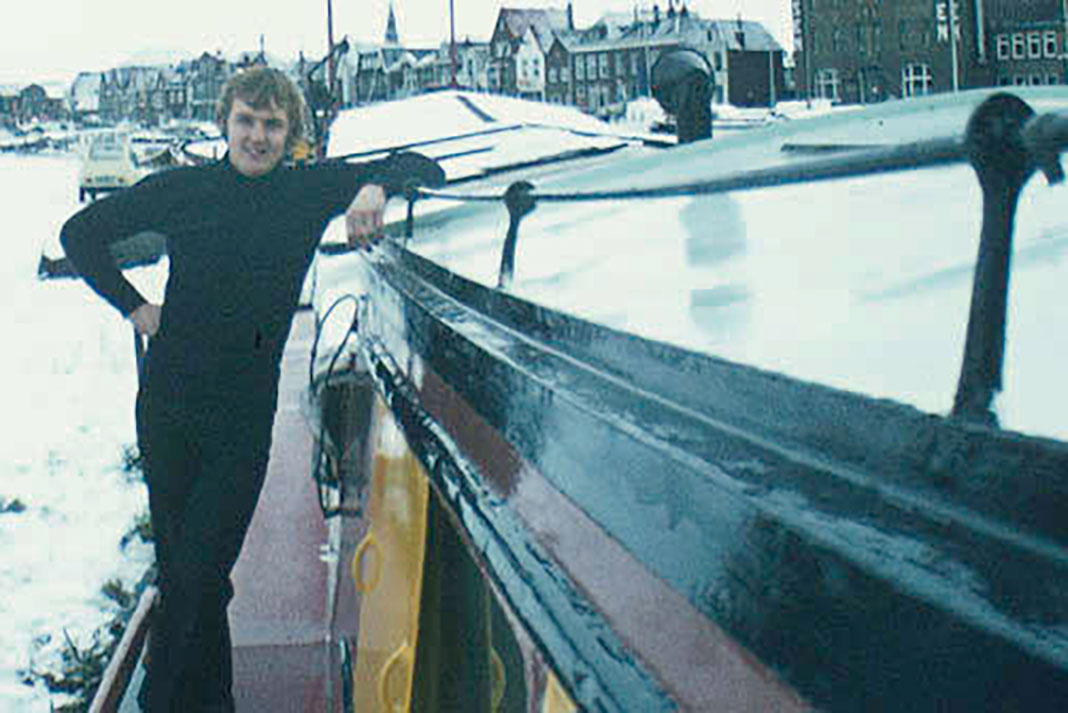
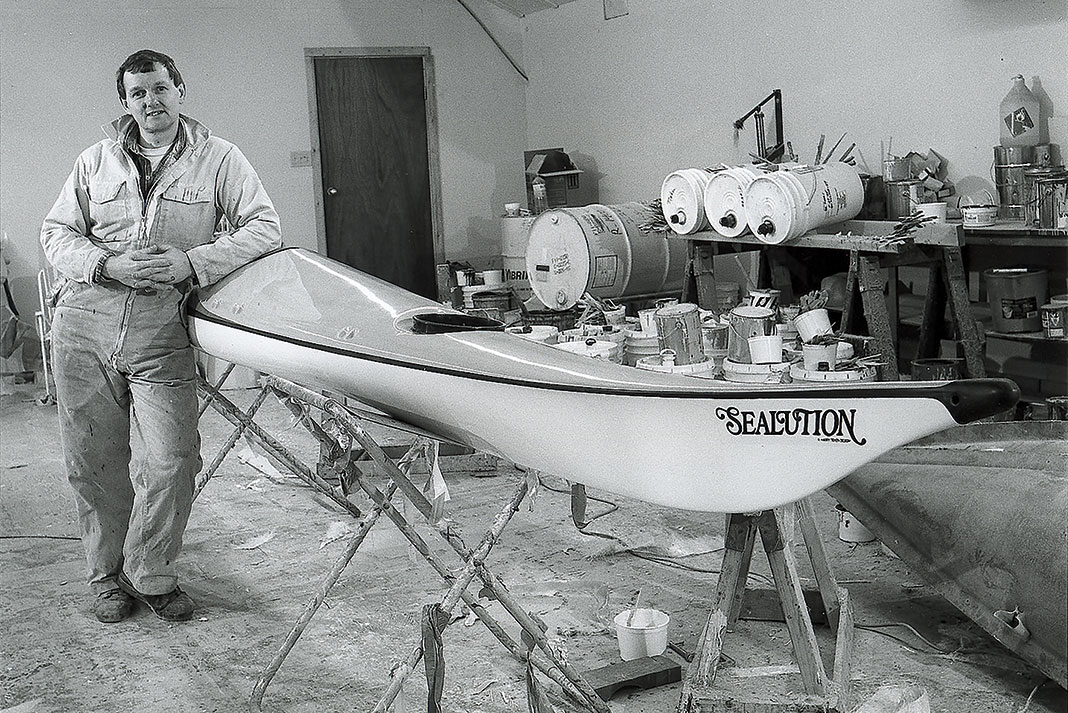
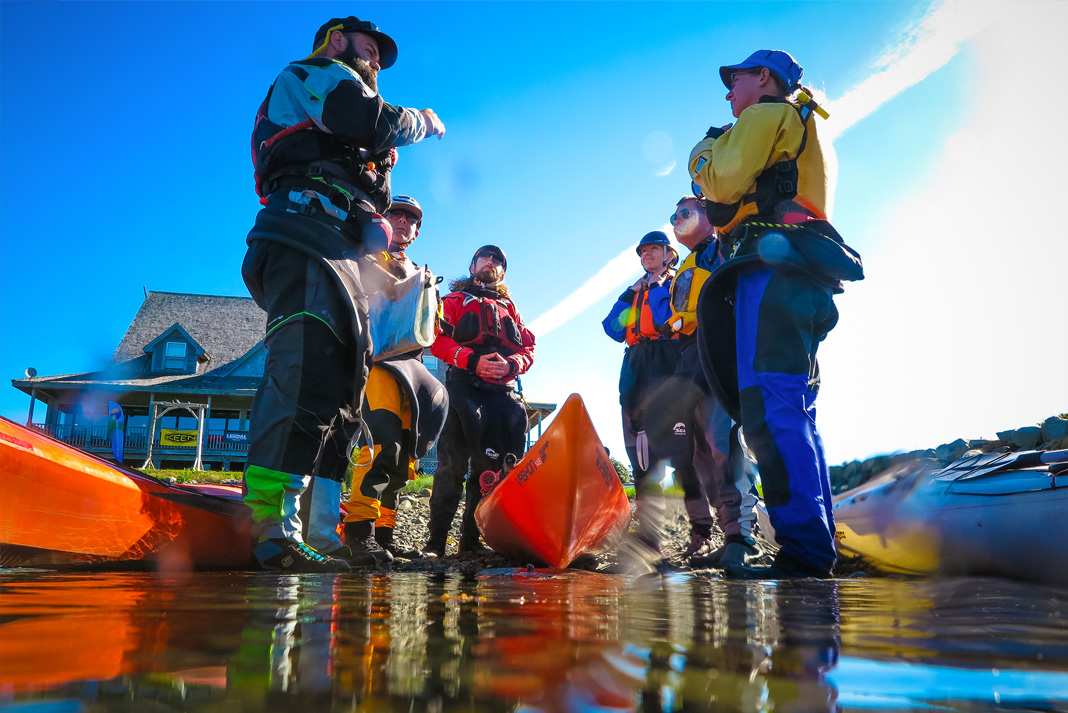
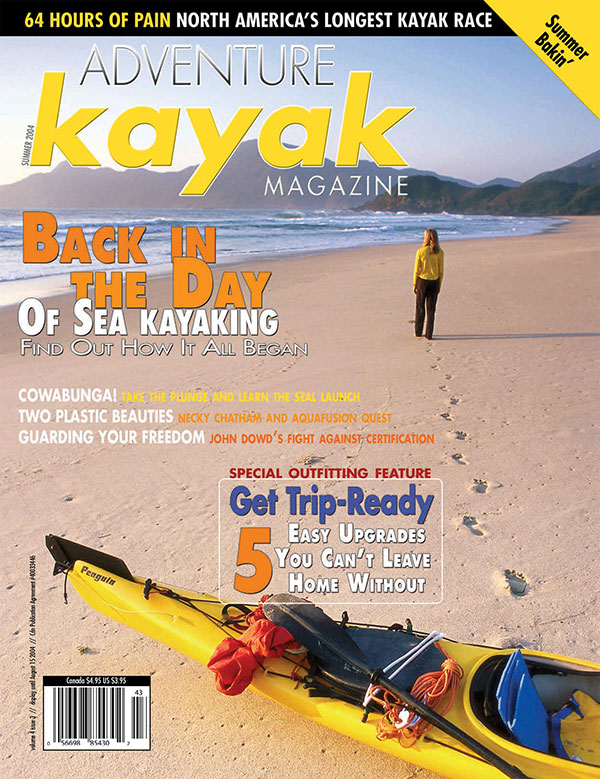 This article was first published in the Summer 2004 issue of Adventure Kayak Magazine.
This article was first published in the Summer 2004 issue of Adventure Kayak Magazine. 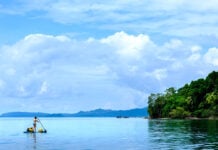


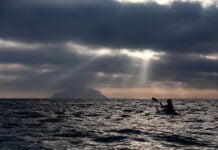
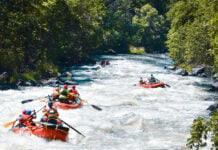

DearTim, So interesting to see the history of sea kayaking as you portray it. I am an 80 year old retired CIA officer who built a kayak from a kit in 1965 (Folbot, company started by J. Kissner, who had worked at Klepper earlier) that I bought for 99 dollars!
And crossed the Chesapeake Bay in it in May 1965!
Own 10 kayaks in several locations, Aquaterra chinook, my first serious kayak, bought in 1981, several from West Side boat shop in NY, an Express from Mariner (best rough water performer,) an Epic 18, and inter alia, a boat from Warren Light craft, which weights 28 lbs, now my most used boat. (They get heavier as you get older!)
If you love the water, and nature, there is nothing better than being in a kayak.
Thanks so much for such an informative article.
David Hunt
Wonderful history of the rise of the sea kayaking industry of which I personally experienced, first as a Feathercraft and Necky dealer in Alaska and later as a board member and then president of TASK. I remember the first symposium and later ones as well, having been a presenter at several. In fact, prior to the first symposia at Port Townsend, all the big players mentioned on the Pacific side attended as presenters and boat reps. It was a wonderful experience. I met Mike Neckar there. Chris Cunningham took over “Sea Kayaker” magazine from John and I wrote a few article for them. I didn’t get involved until the mid 80’s but have stayed involved ever since. Incredible guys, great boats and awesome events and experiences. Thanks for the great overview of the industry.
Nice article that has filled in quite a few gaps in my knowledge, though please excuse me, but it is very N. American centric and can’t by its brevity do the saga full justice.
The first real glass sea kayak I recall being advertised in the UK was a glass version of an Angmagssalik about 1962, but the first I actually saw was Wessex’s Sea Rapier about 1965. The first sea kayak we made at Pyranha was 1973 and was for the Dutch market, about a year after P&H also had started making them and it has been called sea kayaking for at least the 50 years I’ve been in business.
It has also been an enthralling world market since 1865 when John Magregor’s book 1,000 mile in the Rob Roy Canoe inspired the founding of not only the Royal Canoe Club in the UK, but the New York Canoe Club and many others in US and Canada. If it’s of interest, John Macgregors original kayak (now on display in the River and Rowing Museum at Henley) was used by his friend to paddle around the North Cape of Norway (the Nordkapp) in 1867.
Canoes and kayaks have been sold both ways across the pond since then and of course magazines have travelled across even more readily. So there have been much more complex influences from both sides of the pond, for both kayak design and coaching, the complexities and beautiful nuances of which would fill a book to do it justice
Fascinating and good reportage, but no mention of George Dyson and “Baidarka”. Is he not considered significant? He was to me.
Excellent article, thanks for the great read! I miss the old demo days when touring and day tripping SinKs were the main focus…
So many bad things took off in the 80s.
Not every one of us welcome the industrialization of everything. (Oh well, at least a lot of hippies got a lot of money.)
The “good old days of Sea Kayaking, I sure miss hanging out with so many of the folks in this article. We had West Coast Sea Kayak Symposium planning meetings in my basement is West Seattle. I would get pizza and a case of “Beers of the World” from Costco and we would brainstorm on the plans for the next years symposium in Port Townsend, fun times at a great place and moment in time!